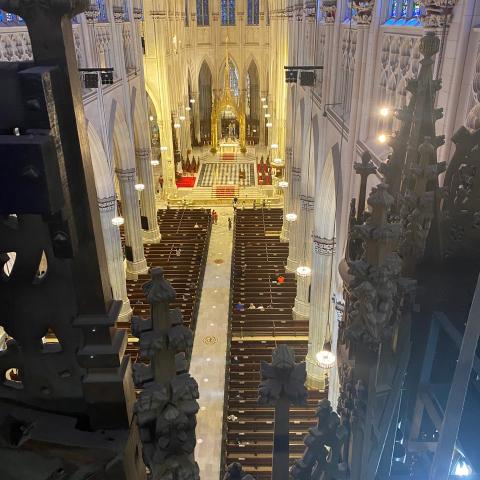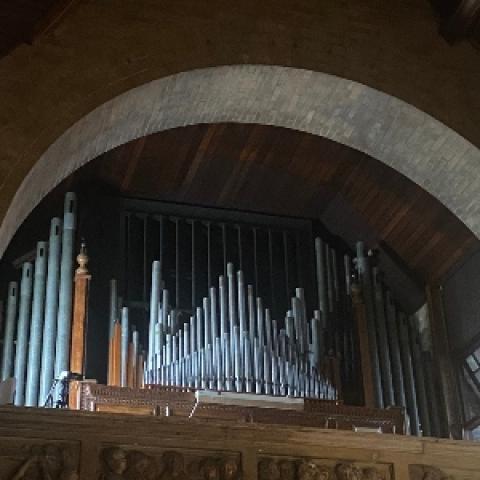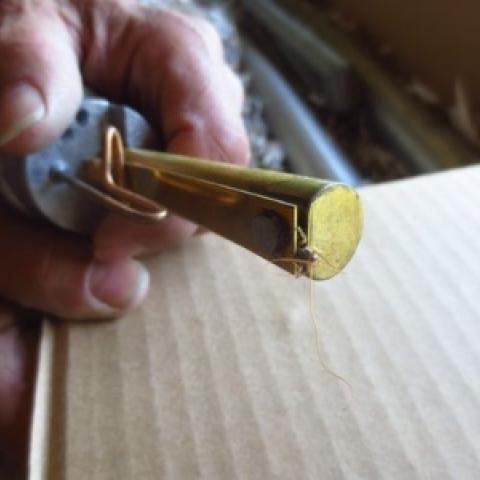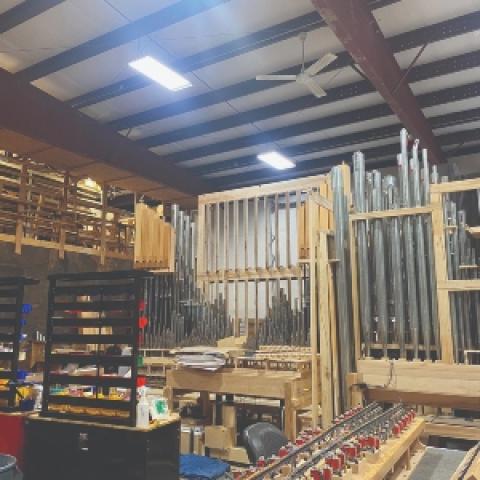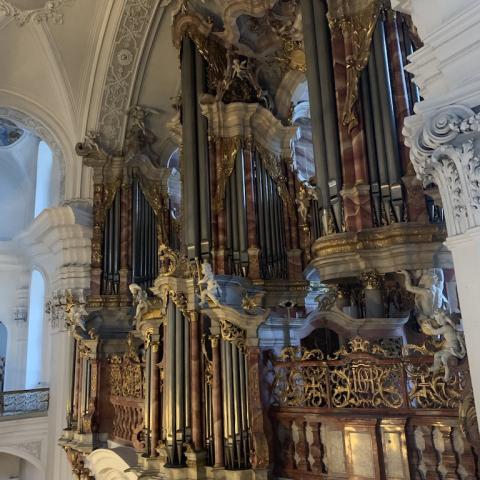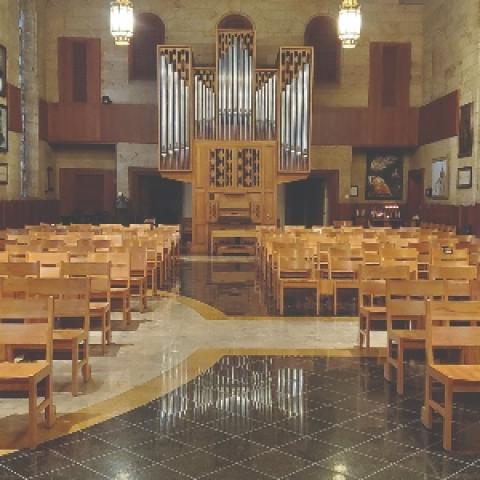
Down front or up in the back?
My home church is the Parish of the Epiphany in Winchester, Massachusetts, where my father was called as rector in 1966 when I was ten years old. The song, “Winchester Cathedral,” written by Geoff Stevens and recorded by The New Vaudeville Band, was released in August of 1966, and Dad received several copies of the recording as gag gifts from friends (Oh voh-dee oh doh). I had three years of piano lessons before we moved to Winchester, but singing in the choir there was my first experience participating in the music of the church. The harpsichord maker Carl Fudge was the organist, and as I have written frequently, he had a lot to do with my early career choices.
The organ at Epiphany, the first I played, was built in 1905 by the Ernest M. Skinner Company (Opus 128), a very early and seriously rundown example of Mr. Skinner’s work. The church is brick, of Gothic influence, and mythically shares proportions with “the” Winchester Cathedral. There is a classic Gothic chancel up several steps from the nave, and the choir was situated in fixed carved oak pews on either side. The Skinner console was on the Epistle side nearest the communion rail, right by the little alleyway through which the congregation returned to their seats in the nave after leaving the rail. I started organ lessons when I was twelve, and my first experience playing in church was when Mr. Fudge allowed me to slip onto the bench and noodle a bit while he received communion.
The church had an ancient forced-hot-air heating system with large registers in the floor. If you were a clever choir member or acolyte, you would finagle standing on one, and your cassock would inflate like a dirigible. There must have been a history of choir members fainting because the choir pews were equipped with smelling salts. These fifty-five-year-old childhood memories bring a burst of nostalgia. I am thinking of Eleanor Banks, the burly alto in the senior choir, who wielded a hairbrush like a nunchuck as the robed junior choir filed out of the choir room. In hindsight, it was good none of us had lice—she would have spread them through the whole choir.
I left Epiphany at thirteen to begin my career as an organist, filling in at the First Baptist Church (with a three-manual Estey), then as organist at Saint Eulalia’s Catholic Church (Conn Artist—you cannot make this stuff up), and then in neighboring Woburn, Massachusetts (three-manual 1860 E. & G. G. Hook, a stupendous organ). While I was building my resumé before leaving town for Oberlin in the fall of 1974, the people of the Parish of the Epiphany were grappling with the condition of the wheezing Skinner organ. In that Boston suburb, we were in the heart and heyday of the tracker revival, and Mr. Fudge with his early music background was advocating a new tracker organ to be placed in a not-yet-built rear gallery.
Meanwhile, down the street . . .
The First Congregational Church in Winchester has a commanding location on a hillside above the town center and an immense steeple that leaves no doubt that the Congregationalists got the concept of “location, location, location.” Their much-rebuilt 1925 Hook & Hastings organ was replaced in 1969 by
C. B. Fisk, Inc., Opus 50, a three-manual, mechanical-action organ with twenty-seven stops. Mr. Fisk wanted to place the organ in the rear balcony, but the church insisted on a chancel installation. His solution was to build a very wide, very shallow organ on the chancel wall. In fact, the organ breaks out of the wall and looms into the chancel airspace. The keydesk is on the floor under the organ facing the opposite wall, and the mechanical action goes under the organist and up the wall to the organ. Large doors open into the hallway behind to expose the action. Originally, there was a setter-board combination action behind that door that has since been replaced with a hundred-level solid-state system.
John Skelton was organist of the First Congregational Church back in the day, and he was my organ teacher through my high school career. The church was a five-minute walk from home, and I had generous practice privileges, spending most weekday afternoons in the thrall of the music and the instrument, learning to wrap my fingers and feet around the notes. Mr. Skelton was a gentle and generous teacher who encouraged and nurtured my passion. I loved working with him, and I loved playing on that organ. In summer of 2021, my son Chris and his wife Alex bought a house near where the Skeltons live, and while I was helping Chris with some repairs and modifications before they moved in, I had a swell evening with John and Carolyn.
A new Fisk organ was installed at the Parish of the Epiphany in 1974, just as I was leaving for Oberlin. It started with twelve stops on two manuals, and seven “prepared for” voices were added in 1983. The parish made the difficult decision to move the music making out of the chancel. The new balcony cost more than the $35,000 organ (imagine, a Fisk organ for $35,000), and while some parishioners were unhappy with the change, the relatively small organ was given a commanding position in the relatively large sanctuary. Of course, people familiar with Fisk organs know that “Charlie” was not known for having trouble filling churches with sound.
I did not play as much on Opus 65 as on Opus 50, but I did play a few recitals, perhaps a dozen services, and my sister’s wedding there. I have not been in that building since my father’s memorial service eight years ago, but I will always love the place and value its role in my earliest experiences with the music of the church. I will also always cherish the privilege of playing such brilliant, responsive organs when I was a pup.
Those two organs make a terrific comparison, built five years apart by the same firm in churches a half mile apart, and placed so radically differently in their buildings. They are both vibrant presences. The chancel placement in the Congregational church is surprisingly successful, partly because the chancel is very wide, so the organ’s sound directly reaches a large percentage of the area of the nave, because the acoustics are lively, and because the organ chamber is barely three feet deep.
The people at Fisk have dubbed these organs “Winchester Old” and “Winchester New,” a tongue-in-cheek reference to the hymntunes for “While Shepherds Watched Their Flocks by Night,” and “On Jordan’s Bank the Baptist’s Cry,” respectively.
As much space as you need?
I am fond of telling clients that there are two rules about placing a pipe organ in a church today. Rule #1: There is never enough money. Rule #2: There is never enough space. I have been in scores of older church buildings in which space was no issue. Think of a Catholic church built in 1880 seating 1,200 people. The ceiling is a barrel vault eighty feet up, so even if the balcony rail is twenty-five above the nave floor, there is still fifty-five feet of ceiling height. It is not unusual to find a nineteenth-century organ that is thirty-five or forty feet tall with a footprint of twenty by thirty feet with room left for a fifty-voice choir. Think of the grand organ formerly in the Church of the Immaculate Conception in Boston, now in storage. It is a rare modern building that will accommodate anything like that. It may be that the only chance of relocating such an organ would be to build a new organ from the pipes down and save the original voicing.
Even Gothic-style cathedrals pose serious challenges for organbuilders. The builders of the ancient cathedrals never imagined that people would be finding spaces for a hundred-plus ranks of organ pipes with all the associated mechanicals. The vaulted ceiling in Saint Patrick’s Cathedral in New York City is 112 feet off the floor, but the two 32′ stops are lying down in the triforium, the Contra Bombarde along Fiftieth Street and the (Double Open Wood) Diapason along Fifty-First Street. At Durham Cathedral, there are, count them, two big Open Wood Diapasons, both standing on the floor in the aisles beside the chancel, the sixteen-footer on the south aisle, and the thirty-two-footer on the north. At York Minster, the 32′ metal Diapason also stands on the floor of the aisle by the chancel, painted to imitate the stone fabric of the wall.
It is often problematic to place pipe organs in newer church buildings. The great interior height in many older church buildings is the result of the desire for proper proportions and the lofty superstructure that supports that high ceiling. Modern construction materials and techniques allow low ceilings to span great distances, and the economics of construction say that as a building gets taller, its cost increases exponentially. Are you paying $500,000 for each additional foot of height? Many modern churches are built without any planned accommodation for an organ, and plenty of architects do not know how much space and what sort of environment an organ needs.
The most extreme experience I have had with this was when a church in Virginia asked me to advise them about placing a pipe organ in their new building. I traveled there to find that although they had asked the architect to provide space for an organ, there was no place in the building to put it. The architect was present at this meeting, and he showed me a photo of an organ façade on the wall of a church and pointed to a space on an outside wall. He blanched when I told him that such an organ would be eight- or ten-feet deep behind the façade. It was an awkward moment. Disappointed, the church bought a digital instrument.
I view the task of evaluating a church building for the placement of an organ as harvesting space. Where in the building might an organ go? Can a classroom be converted to an organ chamber? Can additional height be captured by breaking through a ceiling into attic space? Will the organ be liturgically useful and acoustically successful if we put it there? In newer church buildings, we frequently find a sacristy behind the wall behind the altar. We could harvest the sacristy, open into the attic above, open the wall behind the altar, and make a perfect place for an organ—but I sure have run into opposition when I suggest taking the sacristy.
§
The people of Saint Dunstan’s Episcopal Church in Shoreline, Washington, were willing to rethink and redesign the front of their church to accommodate a new organ. I visited there in 2016 to consult with them and found an amateur installation of a relocated organ with two “flower boxes” perched on the front wall and an enclosed swell stuffed in an attic behind the wall. There was a waist-high wall separating the choir from the altar and two false walls projecting from the front, enclosing the choir in a pseudo-chancel. Jonathan Ortloff’s design for the new organ created a proper chamber front and center. All the artificial barricades were removed, leaving a wide-open, flexible space for clergy, lay leaders, and musicians.
Susanna Valleau is music director at Saint Dunstan’s, a position she has held since before the inception of the organ project. She reports that Ortloff’s design was quickly accepted by the church’s rector and wardens and embraced by the congregation. The new flexibility of the sanctuary has allowed growth in the worship life of the parish as well as opening possibilities for community outreach, especially a variety of concerts.
The chambered organ
In the beginning of the twentieth century, it became popular to place organs in remote chambers, spaces separate from the rooms in which they would be heard. This can be partly attributed to economy—you save a lot of money when you do not have to build a case. It also means that you do not have an organ cluttering up the floor of the sanctuary (if you choose to look at it that way). This would never have been possible as a wide-spread practice without electricity. Electric keyboard actions made it possible to have great distances between keyboards and windchests, and organists had to learn to play by remote control.
Electricity was also crucial in enabling organs to break the bonds of their chambers, thanks to the luxury of virtually limitless wind supplied by electric blowers. Remember, Widor wrote all ten of his organ symphonies for the hand-pumped organ at Saint-Sulpice in Paris, France. Organ builders developed techniques of voicing with higher wind pressures, producing ever-more-powerful sounds. While the wind pressure of a large organ built by E. & G. G. Hook in the 1860s might have been two-and-a-half inches or three inches, it is common to find five inches of pressure on the Great and eight inches on the Swell of a Skinner organ dating from the 1920s, not to mention solo reeds on fifteen inches or twenty-five inches. Air is the fuel we burn to create organ sound. When Mr. Skinner put his Swell celestes and Flauto Dolces on eight inches of pressure, he coaxed them out of the chamber and into the room, stepping on the gas by running more air through the pipes.
Today we can compare the experiences of playing and hearing organs in chambers and in free-standing cases. In fact, there are several American churches where you can hear both in the same room. The First Congregational Church in Columbus, Ohio, has a three-manual organ by Rudolf von Beckerath (1972) in the rear gallery and a four-manual W. W. Kimball (1931) in chancel chambers. What a wealth of organ tone to experience under one roof.
The chapel at Duke University has a four-manual, hundred-rank Aeolian located in chancel chambers and a four-manual, hundred-rank Flentrop in a high gallery on the rear wall. There is also a small Brombaugh organ tuned in meantone in a side chapel. The Organ Historical Society held a national convention in Winston-Salem, North Carolina, in 2001 during which we heard the ultimate comparison of organs with recitals on each of those organs in the same day—Mark Brombaugh played the Flentrop, Margaret Irwin-Brandon played the Brombaugh, and Ken Cowan played the Aeolian. The range of music played was profound, from Frescobaldi to Wagner and Liszt, and conventioneers got a real earful that day.
Prepare the way.
When an institution is planning a room that will include a pipe organ, it is wise to engage an organ expert in the design process. It is a rare architect who would have a deep grasp of the space needed for an organ. In fact, without real practical knowledge, planning the size of an organ is likely to be arbitrary. How many stops must it have? Would it have fewer more powerful stops, or would the tonal variety that comes from a larger number of stops serve the needs of the institution best? These questions apply both to churches and universities. If it should be forty stops, should it be electric or mechanical action? And how do you arrive at forty stops? Where should the organ be placed for best acoustical advantage and logistical usefulness? You do not want to place a mechanical-action organ with an attached keydesk alone in a gallery with choir seating on the floor under it or at the other end of the room. The independent organ consultant can help answer all these questions without the conflict of angling for the contract to build the organ.
What will be the electrical requirements? How much might the organ weigh? How are the building’s walls constructed to maximize their effective resonance? In a recent job where an organ was removed for renovation and returned to its original location, the flimsy drywall behind the organ was reinforced with new heavy material, and the effect on the organ’s sound was dramatic.
Because the pipe organ is a monumental instrument, it relies on the integrity of its building for the projection of its sound. The building must provide the organ a safe and solid home. Flimsy construction absorbs sound. Rigid construction projects it. The organ should not be placed under valleys in the roof that would be prone to leak. Witness that the Cavaillé-Coll organ at Notre-Dame de Paris miraculously survived the catastrophic fire in 2019; the peaked roof above the organ between the two towers protected the instrument during that horrible event.
In many churches, it is obvious where the organ should go. In others, not so much. When you are going to the trouble and expense of acquiring an organ, set the stage well and get it right.

